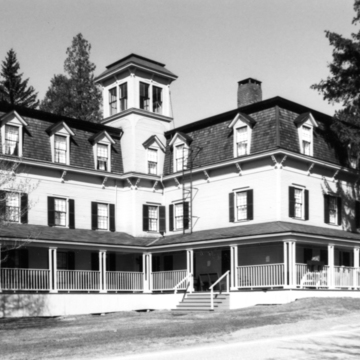Breadloaf Inn is a rare intact example of Vermont's Victorian resort architecture that also has important associations with the environmental movement and for American literature. Middlebury eccentric and philanthropist Joseph Battell developed it over a period of three-and-a-half decades on a Ripton farmstead where he summered for his health. He began to amass and protect all of the salubrious mountain landscape he could see from his retreat, with the dream of assembling a wilderness area for the people of the northeastern United States on the model of the national parks being established in the West. By the time of his death, Battell controlled more than thirty-one thousand acres. At their core he built Breadloaf, named for a nearby mountain, as his summer home and a place for paying guests. Most visitors arrived in Middlebury by train and transferred to horse-drawn buggies for the trip to the mountains, a testimony to Battell's enthusiasm for horses and, later, his equal hatred for motorcars (see AD19). In 1882 he commissioned his personal architect-builder, Clinton G. Smith, to remodel and expand the large farmhouse-like structure into the mansard-roofed Breadloaf Inn, with its wraparound veranda and crowning belvedere. Smith also designed a mansard-roofed barn (1885) and two large annexes (1885) with porches and galleries. Across the road, guest cottages were built in an array of styles. A bowling alley and the original little theater burned, but other facilities such as the Adirondack Rustic Printer's Cabin (c. 1895) and Tea House (c. 1890) survive from Battell's time.
At Battell's death in 1915, his vast mountain estate was left to Middlebury College. Beginning in 1920 the college brought the seasonal inn back to life as the summer Breadloaf School of English. In 1926 the college added the Breadloaf Writers' Conference, drawing such luminaries as poet Robert Frost, who acquired a neighboring farm as his summer home from 1940 to 1963. In the 1930s, the college added buildings in the Colonial Revival style and sold most of the forests to the federal government for incorporation as the core of the northern range of the Green Mountain National Forest.


